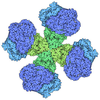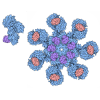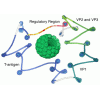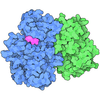[English] 日本語
 Yorodumi
Yorodumi- PDB-8pvu: Cryo-EM structure of DHS-ERK2 complex with 1:1 stoichiometry refi... -
+ Open data
Open data
- Basic information
Basic information
| Entry | Database: PDB / ID: 8pvu | ||||||||||||
|---|---|---|---|---|---|---|---|---|---|---|---|---|---|
| Title | Cryo-EM structure of DHS-ERK2 complex with 1:1 stoichiometry refined in C1 symmetry | ||||||||||||
 Components Components |
| ||||||||||||
 Keywords Keywords | TRANSLATION / hypusination / transferase / protein-protein interaction / ERK1/2 kinase-independent function | ||||||||||||
| Function / homology |  Function and homology information Function and homology informationpeptidyl-lysine modification to peptidyl-hypusine / deoxyhypusine synthase / Hypusine synthesis from eIF5A-lysine / deoxyhypusine synthase activity / spermidine metabolic process / spermidine catabolic process / phospho-PLA2 pathway / interleukin-34-mediated signaling pathway / Signaling by MAPK mutants / RAF-independent MAPK1/3 activation ...peptidyl-lysine modification to peptidyl-hypusine / deoxyhypusine synthase / Hypusine synthesis from eIF5A-lysine / deoxyhypusine synthase activity / spermidine metabolic process / spermidine catabolic process / phospho-PLA2 pathway / interleukin-34-mediated signaling pathway / Signaling by MAPK mutants / RAF-independent MAPK1/3 activation / Suppression of apoptosis / Gastrin-CREB signalling pathway via PKC and MAPK / Signaling by Activin / cardiac neural crest cell development involved in heart development / caveolin-mediated endocytosis / cytosine metabolic process / response to epidermal growth factor / Signaling by NODAL / ERKs are inactivated / Signaling by MAP2K mutants / RSK activation / Golgi Cisternae Pericentriolar Stack Reorganization / Regulation of the apoptosome activity / positive regulation of macrophage proliferation / regulation of cellular pH / outer ear morphogenesis / Signaling by LTK in cancer / regulation of Golgi inheritance / positive regulation of peptidyl-threonine phosphorylation / ERBB signaling pathway / labyrinthine layer blood vessel development / mammary gland epithelial cell proliferation / trachea formation / Negative feedback regulation of MAPK pathway / regulation of early endosome to late endosome transport / IFNG signaling activates MAPKs / regulation of stress-activated MAPK cascade / Frs2-mediated activation / positive regulation of macrophage chemotaxis / ERBB2-ERBB3 signaling pathway / Activation of the AP-1 family of transcription factors / regulation of cytoskeleton organization / ERK/MAPK targets / RUNX2 regulates osteoblast differentiation / response to exogenous dsRNA / MAPK1 (ERK2) activation / pseudopodium / lung morphogenesis / face development / positive regulation of telomere maintenance / Bergmann glial cell differentiation / Recycling pathway of L1 / thyroid gland development / Advanced glycosylation endproduct receptor signaling / peptidyl-threonine phosphorylation / MAP kinase activity / regulation of ossification / negative regulation of cell differentiation / Regulation of HSF1-mediated heat shock response / RHO GTPases Activate NADPH Oxidases / Estrogen-dependent nuclear events downstream of ESR-membrane signaling / mitogen-activated protein kinase / RHO GTPases Activate WASPs and WAVEs / Signal attenuation / phosphatase binding / Growth hormone receptor signaling / Schwann cell development / Estrogen-stimulated signaling through PRKCZ / stress-activated MAPK cascade / Nuclear events stimulated by ALK signaling in cancer / NPAS4 regulates expression of target genes / ERK1 and ERK2 cascade / positive regulation of T cell proliferation / phosphotyrosine residue binding / myelination / Transcriptional and post-translational regulation of MITF-M expression and activity / NCAM signaling for neurite out-growth / RNA polymerase II CTD heptapeptide repeat kinase activity / insulin-like growth factor receptor signaling pathway / ESR-mediated signaling / lipopolysaccharide-mediated signaling pathway / cellular response to amino acid starvation / thymus development / Regulation of PTEN gene transcription / Signal transduction by L1 / B cell receptor signaling pathway / response to nicotine / FCGR3A-mediated phagocytosis / FCERI mediated MAPK activation / Negative regulation of FGFR3 signaling / Negative regulation of FGFR2 signaling / Negative regulation of FGFR4 signaling / Downregulation of SMAD2/3:SMAD4 transcriptional activity / Negative regulation of FGFR1 signaling / SMAD2/SMAD3:SMAD4 heterotrimer regulates transcription / positive regulation of cholesterol biosynthetic process / Spry regulation of FGF signaling / Signaling by high-kinase activity BRAF mutants / MAP2K and MAPK activation / Oncogene Induced Senescence Similarity search - Function | ||||||||||||
| Biological species |  Homo sapiens (human) Homo sapiens (human) | ||||||||||||
| Method | ELECTRON MICROSCOPY / single particle reconstruction / cryo EM / Resolution: 3.5 Å | ||||||||||||
 Authors Authors | Kochanowski, P. / Biela, A.P. / Grudnik, P. | ||||||||||||
| Funding support |  Poland, 3items Poland, 3items
| ||||||||||||
 Citation Citation |  Journal: Cell Rep / Year: 2024 Journal: Cell Rep / Year: 2024Title: ERK1/2 interaction with DHPS regulates eIF5A deoxyhypusination independently of ERK kinase activity. Authors: Andrew E Becker / Paweł Kochanowski / Pui-Kei Wu / Elżbieta Wątor / Wenjing Chen / Koushik Guchhait / Artur P Biela / Przemysław Grudnik / Jong-In Park /   Abstract: This study explores a non-kinase effect of extracellular regulated kinases 1/2 (ERK1/2) on the interaction between deoxyhypusine synthase (DHPS) and its substrate, eukaryotic translation initiation ...This study explores a non-kinase effect of extracellular regulated kinases 1/2 (ERK1/2) on the interaction between deoxyhypusine synthase (DHPS) and its substrate, eukaryotic translation initiation factor 5A (eIF5A). We report that Raf/MEK/ERK activation decreases the DHPS-ERK1/2 interaction while increasing DHPS-eIF5A association in cells. We determined the cryoelectron microscopy (cryo-EM) structure of the DHPS-ERK2 complex at 3.5 Å to show that ERK2 hinders substrate entrance to the DHPS active site, subsequently inhibiting deoxyhypusination in vitro. In cells, impairing the ERK2 activation loop, but not the catalytic site, prolongs the DHPS-ERK2 interaction irrespective of Raf/MEK signaling. The ERK2 Ser-Pro-Ser motif, but not the common docking or F-site recognition sites, also regulates this complex. These data suggest that ERK1/2 dynamically regulate the DHPS-eIF5A interaction in response to Raf/MEK activity, regardless of its kinase function. In contrast, ERK1/2 kinase activity is necessary to regulate the expression of DHPS and eIF5A. These findings highlight an ERK1/2-mediated dual kinase-dependent and -independent regulation of deoxyhypusination. | ||||||||||||
| History |
|
- Structure visualization
Structure visualization
| Structure viewer | Molecule:  Molmil Molmil Jmol/JSmol Jmol/JSmol |
|---|
- Downloads & links
Downloads & links
- Download
Download
| PDBx/mmCIF format |  8pvu.cif.gz 8pvu.cif.gz | 277 KB | Display |  PDBx/mmCIF format PDBx/mmCIF format |
|---|---|---|---|---|
| PDB format |  pdb8pvu.ent.gz pdb8pvu.ent.gz | 223.3 KB | Display |  PDB format PDB format |
| PDBx/mmJSON format |  8pvu.json.gz 8pvu.json.gz | Tree view |  PDBx/mmJSON format PDBx/mmJSON format | |
| Others |  Other downloads Other downloads |
-Validation report
| Summary document |  8pvu_validation.pdf.gz 8pvu_validation.pdf.gz | 1.2 MB | Display |  wwPDB validaton report wwPDB validaton report |
|---|---|---|---|---|
| Full document |  8pvu_full_validation.pdf.gz 8pvu_full_validation.pdf.gz | 1.3 MB | Display | |
| Data in XML |  8pvu_validation.xml.gz 8pvu_validation.xml.gz | 57 KB | Display | |
| Data in CIF |  8pvu_validation.cif.gz 8pvu_validation.cif.gz | 84 KB | Display | |
| Arichive directory |  https://data.pdbj.org/pub/pdb/validation_reports/pv/8pvu https://data.pdbj.org/pub/pdb/validation_reports/pv/8pvu ftp://data.pdbj.org/pub/pdb/validation_reports/pv/8pvu ftp://data.pdbj.org/pub/pdb/validation_reports/pv/8pvu | HTTPS FTP |
-Related structure data
| Related structure data |  17972MC M: map data used to model this data C: citing same article ( |
|---|---|
| Similar structure data | Similarity search - Function & homology  F&H Search F&H Search |
- Links
Links
- Assembly
Assembly
| Deposited unit | 
|
|---|---|
| 1 |
|
- Components
Components
| #1: Protein | Mass: 41531.730 Da / Num. of mol.: 1 Source method: isolated from a genetically manipulated source Source: (gene. exp.)  Homo sapiens (human) / Gene: MAPK1, ERK2, PRKM1, PRKM2 / Production host: Homo sapiens (human) / Gene: MAPK1, ERK2, PRKM1, PRKM2 / Production host:  References: UniProt: P28482, mitogen-activated protein kinase | ||
|---|---|---|---|
| #2: Protein | Mass: 41099.512 Da / Num. of mol.: 4 Source method: isolated from a genetically manipulated source Source: (gene. exp.)  Homo sapiens (human) / Gene: DHPS, DS / Production host: Homo sapiens (human) / Gene: DHPS, DS / Production host:  Has protein modification | N | |
-Experimental details
-Experiment
| Experiment | Method: ELECTRON MICROSCOPY |
|---|---|
| EM experiment | Aggregation state: PARTICLE / 3D reconstruction method: single particle reconstruction |
- Sample preparation
Sample preparation
| Component | Name: Complex of DHS-ERK2 with 1:1 stoichiometry / Type: COMPLEX / Entity ID: all / Source: RECOMBINANT |
|---|---|
| Molecular weight | Experimental value: NO |
| Source (natural) | Organism:  Homo sapiens (human) Homo sapiens (human) |
| Source (recombinant) | Organism:  |
| Buffer solution | pH: 7.8 / Details: 50mM Tris-HCl, 200mM NaCl, 3mM 2-mercaptoethanol |
| Specimen | Conc.: 0.35 mg/ml / Embedding applied: NO / Shadowing applied: NO / Staining applied: NO / Vitrification applied: YES Details: Complex was stabilized with bis(sulfosuccinimidyl)suberate |
| Specimen support | Grid material: COPPER / Grid mesh size: 200 divisions/in. / Grid type: Quantifoil R2/1 |
| Vitrification | Instrument: FEI VITROBOT MARK IV / Cryogen name: ETHANE / Humidity: 95 % / Chamber temperature: 278 K / Details: blot time: 2 s, blot force: 0 |
- Electron microscopy imaging
Electron microscopy imaging
| Experimental equipment |  Model: Titan Krios / Image courtesy: FEI Company |
|---|---|
| Microscopy | Model: FEI TITAN KRIOS |
| Electron gun | Electron source:  FIELD EMISSION GUN / Accelerating voltage: 300 kV / Illumination mode: FLOOD BEAM FIELD EMISSION GUN / Accelerating voltage: 300 kV / Illumination mode: FLOOD BEAM |
| Electron lens | Mode: BRIGHT FIELD / Nominal magnification: 105000 X / Nominal defocus max: 2400 nm / Nominal defocus min: 900 nm / Cs: 2.7 mm / C2 aperture diameter: 50 µm |
| Specimen holder | Specimen holder model: FEI TITAN KRIOS AUTOGRID HOLDER |
| Image recording | Electron dose: 40.16 e/Å2 / Film or detector model: GATAN K3 (6k x 4k) / Num. of real images: 6930 |
| EM imaging optics | Energyfilter name: GIF Bioquantum / Energyfilter slit width: 20 eV |
- Processing
Processing
| EM software |
| ||||||||||||||||||||||||||||||||||||||||||||
|---|---|---|---|---|---|---|---|---|---|---|---|---|---|---|---|---|---|---|---|---|---|---|---|---|---|---|---|---|---|---|---|---|---|---|---|---|---|---|---|---|---|---|---|---|---|
| Image processing | Details: motion corrected in Relion and further processed in cryoSPARC | ||||||||||||||||||||||||||||||||||||||||||||
| CTF correction | Type: PHASE FLIPPING AND AMPLITUDE CORRECTION | ||||||||||||||||||||||||||||||||||||||||||||
| Particle selection | Num. of particles selected: 438 / Details: Manually picked | ||||||||||||||||||||||||||||||||||||||||||||
| Symmetry | Point symmetry: C1 (asymmetric) | ||||||||||||||||||||||||||||||||||||||||||||
| 3D reconstruction | Resolution: 3.5 Å / Resolution method: FSC 0.143 CUT-OFF / Num. of particles: 146572 / Algorithm: BACK PROJECTION / Num. of class averages: 1 / Symmetry type: POINT | ||||||||||||||||||||||||||||||||||||||||||||
| Atomic model building | Protocol: FLEXIBLE FIT / Space: REAL | ||||||||||||||||||||||||||||||||||||||||||||
| Atomic model building | 3D fitting-ID: 1 / Source name: PDB / Type: experimental model
| ||||||||||||||||||||||||||||||||||||||||||||
| Refine LS restraints |
|
 Movie
Movie Controller
Controller











 PDBj
PDBj

































